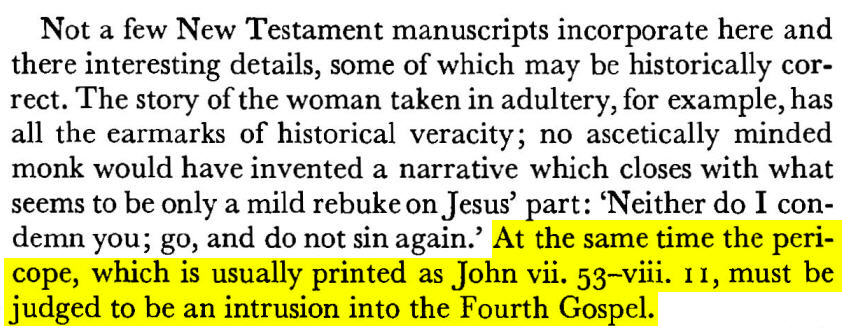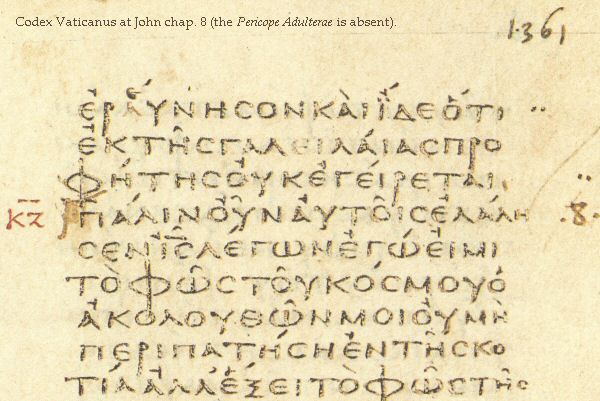There is general agreement that the verses from John 7:53 to John 8:11 were not written by the author or authors who wrote the rest of the gospel. There is little consensus as to exactly when the forgery was inserted.
Chris Keith is professor of New Testament and Early Christianity at St Mary's University where he also serves as Director of the Centre for the Social-Scientific Study of the Bible.
The story of the woman caught in adultery, typically located at John 8:1-8:11, is one of the most popular stories in the entire Bible. Jesus’ lack of condemnation of a known sinner captivates some readers, as does his statement “Let anyone among you who is without sin
be the first to throw a stone at her” (John 8:7) and the manner in which he outwits the scribes and the Pharisees with that statement. Since, as his opponents note (John 8:5), the law of Moses demanded that an adulteress be killed, Jesus’ opponents have thrust him upon the horns of a dilemma. He has to choose either to allow
the woman to go free and publicly disobey the law of Moses or to approve of her killing and forfeit his reputation as a friend to sinners (and possibly risk trouble with Rome for contributing to a capital punishment that they
had not sanctioned). The cleverness of Jesus’ response in John 8:7 is that it renders the enactment of the legal punishment impossible without requiring his public disavowal of the law.
Interestingly enough, the earliest manuscripts of the Gospel of John do not contain this beloved passage. Indeed, the first manuscript to contain the story is from around 400 C.E. Around 4% of Greek manuscripts
that include the passage place it in locations other than John 8:1-8:11; the earliest of these is from around the ninth and tenth centuries C.E. This perplexing manuscript history fuels debates about whether
the story was originally in John’s Gospel and, if so, where. The majority of scholars believe a later Christian scribe inserted the passage into John’s Gospel at John 8:1-8:11 and that the alternate locations are due to the effects of later liturgical reading in what is known as the lectionary system. [ Chris Keith, "Manuscript History and John 8:1-8:11", n.p. [cited 21 Apr 2017]. Online: http://www.bibleodyssey.org/en/passages/related-articles/Manuscript History and John].
The text of the New Testament : It’s Transmission Corruption
and RestorationSecond Edition By Bruce M. Metzger Page 223
Manuscripts that doesn’t conain the story:
.
Daniel B. Wallace* on the fake story:
https://www.youtube.com/watch?v=cobVbGs5yXM
(*= Senior Research Professor of New Testament Studies at Dallas Theological Seminary)
Bart Ehrman** on the fake story:
(*= Senior Research Professor of New Testament Studies at Dallas Theological Seminary)
Bart Ehrman** on the fake story:
https://www.youtube.com/watch?v=MhIUkF_FT2I
(**= James A. Gray Distinguished Professor, Department of Religious Studies at the University of North Carolina at Chapel Hill)
(**= James A. Gray Distinguished Professor, Department of Religious Studies at the University of North Carolina at Chapel Hill)
Below is an image of page NB (52) of Papyrus 66, a codex of John's Gospel from about AD 200. The begins in the middle of the word εραυνησον ("search")
in John 7:52. On the second line the sentence ends with a punctuation mark and is immediately followed by Παλιν ουν αυτοις ελαλησεν ο Ις ("again Jesus spoke to them") in 8:12, omitting the Story of the Adulteress.
The manuscript has been annotated by a scribe who used diagonal strokes to indicate a word-order variant in the first and second lines, but the Story of the Adulteress is omitted without any notation.
The manuscript has been annotated by a scribe who used diagonal strokes to indicate a word-order variant in the first and second lines, but the Story of the Adulteress is omitted without any notation.
The New Commentary on the Whole Bible
"This story is not included in the best and earliest manuscripts [of John]. In fact, it is absent from all witnesses earlier than the 9th century, with the exception of a
fifth century Greek-Latin manuscript. No Greek church father comments on the passage prior to the 12th century.Jamieson et al, "The New Commentary on the Whole Bible", Tyndale, Wheaton IL (1990), P. 247-248
The "Interpreter's One Volume Commentary on the Bible"
"7:53-8:11: This passage is omitted or set off in modern editions of the gospel since it does not appear in the oldest and best manuscripts and is apparently a later interpolation. In some manuscripts it occurs after Luke 21:38
The Five Gospels
"The story of the woman caught in the act of adultery...was a 'floating' or 'orphan' story. It is almost certainly not a part of the
original text of John, but is a noteworthy tradition nonetheless...While the Fellows [of the Jesus Seminar] agreed that the words did not originate in their present form with Jesus, they nevertheless assigned the words and
story to a special category of things they wish Jesus had said and done."



